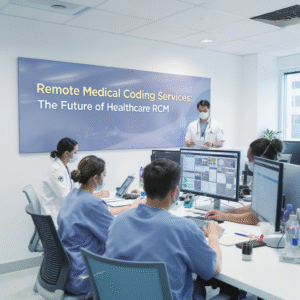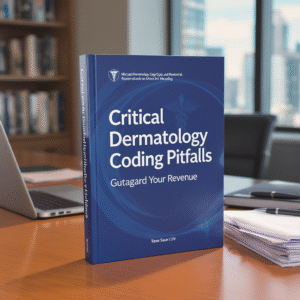2025 Dermatology CPT & Coding Updates: Your Complete Practice Survival Guide
Coding
Coding
The medical coding landscape continues its relentless evolution, and 2025 presents dermatology practices with both unprecedented challenges and exciting opportunities. With healthcare reimbursement becoming increasingly complex and competitive, staying ahead of coding changes isn’t just about compliance—it’s about ensuring your practice’s financial survival and growth in an ever-changing healthcare environment.

The American Medical Association (AMA) has unveiled its comprehensive 2025 CPT code set, featuring a staggering 420 total changes that will reshape how dermatological services are documented, billed, and reimbursed. These modifications include 270 brand-new codes, 112 deletions of outdated procedures, and 38 significant revisions to existing codes. For dermatology practices, these updates represent the most substantial coding overhaul in recent years, directly impacting revenue streams, documentation requirements, and operational workflows.
The Financial Stakes: Why Getting This Right Matters More Than Ever
Before diving into specific updates, it’s crucial to understand the broader financial context facing dermatology practices in 2025. The Centers for Medicare & Medicaid Services (CMS) has implemented a nearly 2.83% reduction in Medicare physician payments, continuing a troubling trend of declining reimbursement rates that has persisted for over a decade. This reduction, combined with rising operational costs and increased regulatory complexity, means that accurate coding and billing have never been more critical to practice sustainability.
Consider this: a typical dermatology practice that fails to properly implement these 2025 coding changes could see a 5-8% reduction in overall revenue within the first quarter alone. Conversely, practices that proactively adapt and optimize their coding processes often see improved cash flow and reduced claim denials, creating a competitive advantage in an increasingly challenging marketplace.
1. Telemedicine Revolution: Navigating the New Virtual Care Landscape
The telemedicine sector continues its rapid evolution, with 2025 bringing significant changes that will fundamentally alter how dermatologists deliver and bill for virtual care services. The deletion of traditional telephone E/M codes (99441-99443) marks the end of an era, replaced by a more sophisticated and specific coding structure designed to better reflect the realities of modern telehealth delivery.
New Synchronous Audio-Video E/M Codes (98000-98007)
These new codes represent a paradigm shift in how virtual dermatology consultations are categorized and reimbursed. Unlike their predecessors, these codes distinguish between new and established patients while providing greater specificity for different levels of service complexity. The introduction of code 98016 for brief virtual check-ins replaces the temporary G2012 code, offering a permanent solution for quick patient follow-ups and medication management visits.
Strategic Implementation for Your Practice:
- Audit Your Current Telehealth Setup: Review your existing telehealth infrastructure to ensure it meets the technical requirements for the new codes. Audio-video synchronous communication requires reliable, HIPAA-compliant platforms that can document connection quality and session duration.
- Develop Service-Specific Protocols: Create standardized workflows for different types of virtual visits. A brief virtual check-in (98016) requires different documentation than a comprehensive new patient consultation (98000-98007 series).
- Train Staff on Technology Documentation: Your support staff must understand how to properly document the technology used, connection quality, and any technical issues that arise during virtual visits, as these factors increasingly impact reimbursement decisions.
- Payer-Specific Strategy Development: While the AMA has established these codes, individual payers maintain varying policies regarding telehealth reimbursement. Develop payer-specific strategies and maintain updated contracts that reflect current telehealth policies.

2. Enhanced Precision in Skin Procedures: The Documentation Revolution
Dermatology’s bread-and-butter procedures—biopsies and excisions—have undergone significant refinement in 2025, with revised codes for skin biopsies (11102–11107) and excisions (11400–11646) demanding unprecedented levels of documentation specificity.
The New Documentation Imperative
Payers are now requiring granular documentation that goes far beyond simple procedure notes. For excisions, practices must document lesion size before the procedure begins, including detailed measurements of margins and depth assessments. This shift reflects payers’ increasing focus on medical necessity and appropriate resource utilization.
Critical Success Factors:
- Pre-Procedure Photography Protocol: Implement standardized photography protocols that capture lesion size, location, and characteristics before any intervention. These images serve as crucial documentation supporting your coding decisions and can significantly reduce claim denials.
- Enhanced EHR Templates: Redesign your electronic health record templates to capture all required data points automatically. Include dropdown menus for lesion characteristics, measurement fields with automatic calculation capabilities, and standardized language that meets payer requirements.
- Provider Education on Measurement Standards: Ensure all physicians understand the new measurement requirements and use consistent methodologies. Consider investing in precision measurement tools and training staff on their proper use.
Mohs Surgery: Navigating Increased Scrutiny
Mohs micrographic surgery codes (17311–17315) face heightened scrutiny from both Medicare contractors and commercial payers. The enhanced documentation requirements now include detailed justification for choosing Mohs over alternative treatments, comprehensive layer-by-layer pathology reporting, and in some regions, mandatory pre- and post-operative photographic documentation.
Advanced Mohs Documentation Strategies:
- Develop Comprehensive Justification Templates: Create standardized documentation that clearly articulates why Mohs surgery represents the most appropriate treatment option, including anatomical considerations, lesion characteristics, and patient-specific factors.
- Implement Layer-by-Layer Tracking Systems: Establish robust systems for tracking and documenting each surgical layer, including tissue mapping, pathology findings, and reconstruction decisions.
- Regional Policy Awareness: Stay informed about regional Medicare contractor policies, as requirements can vary significantly by geographic location.
3. Breakthrough Technologies: Skin Cell Suspension Autografts
The introduction of eight new codes (15011-15018) for skin cell suspension autografts (SCSA) represents one of the most exciting developments in dermatological coding for 2025. These codes reflect significant advances in burn treatment and reconstructive surgery techniques, offering new revenue opportunities for practices equipped to perform these sophisticated procedures.
Understanding SCSA Coding Structure
These new codes comprehensively cover the entire SCSA process, from initial cell harvest and laboratory preparation to final application and post-procedure care. The coding structure recognizes the complexity and resource intensity of these procedures while providing appropriate reimbursement levels.
Implementation Considerations:
- Equipment and Training Requirements: SCSA procedures require specialized equipment and extensive provider training. Evaluate whether your practice has the resources and patient volume to justify implementation.
- Documentation Complexity Management: These procedures generate extensive documentation requirements. Develop streamlined workflows that capture all necessary information without overwhelming clinical staff.
- Payer Coverage Analysis: Research individual payer policies regarding SCSA coverage, as adoption rates vary significantly among insurance companies.
4. ICD-10-CM Evolution: Diagnostic Precision Enhancement
The October 1st ICD-10-CM updates bring remarkable improvements in diagnostic specificity, particularly benefiting dermatology practices through expanded classification options and enhanced clinical precision.
Key Diagnostic Enhancements
Actinic Keratosis Expansion: New subcategories allow for more precise classification of actinic keratosis variations, supporting better treatment planning and outcomes tracking.
Drug-Induced Skin Reactions: Enhanced specificity in coding drug-induced skin reactions improves pharmacovigilance reporting and supports better patient safety initiatives.
Autoimmune Skin Conditions: More detailed classifications for conditions like lupus, dermatomyositis, and scleroderma support improved research outcomes and treatment protocols.
Pruritus and Scarring Alopecia: New codes including “Other specified pruritus” (L29.89) and refined lichen planopilaris classifications (L66.1 subdivisions) provide better diagnostic granularity.

Strategic Diagnostic Coding:
- Provider Education on Specificity: Train physicians to think more granularly about diagnoses, emphasizing the clinical and financial benefits of precise coding.
- Software Integration Management: Ensure your practice management and EHR systems integrate seamlessly with updated ICD-10-CM databases, preventing coding errors and claim delays.
- Quality Metrics Integration: Use enhanced diagnostic specificity to improve quality metrics reporting and participate in value-based care initiatives.
5. Modifier Mastery: Avoiding the Denial Trap
Incorrect modifier usage continues plaguing dermatology practices, with enhanced scrutiny from CMS and commercial payers making precision more critical than ever. The most problematic modifiers—25, 59, and 24—require particular attention and systematic approaches to proper application.
Advanced Modifier Strategies
Modifier -25 Optimization: Document separately identifiable E/M services with clear clinical reasoning that demonstrates medical necessity beyond the procedure’s normal pre- and post-service work.
Modifier -59 Precision: Use distinct procedural service modifiers only when procedures are truly separate and distinct, with clear anatomical or temporal separation.
Modifier -24 Mastery: Ensure unrelated E/M services during global periods are truly unrelated and properly documented with supporting medical records.
Implementation Tactics:
- Real-Time Decision Support: Implement EHR-based decision support tools that prompt appropriate modifier usage based on procedure combinations and timing.
- Regular Audit Programs: Establish monthly internal audits focusing specifically on modifier usage patterns and denial trends.
- Denial Analysis and Feedback Loops: Create systematic processes for analyzing modifier-related denials and providing targeted feedback to clinical and billing staff.
6. Revenue Cycle Optimization: Thriving Despite Payment Reductions
With Medicare payment reductions and increasing operational costs, dermatology practices must optimize every aspect of their revenue cycle to maintain financial health.
Advanced Revenue Cycle Strategies
Proactive Denial Management: Implement predictive analytics to identify potential denials before claim submission, reducing rework and accelerating payment cycles.
Clean Claim Rate Optimization: Target clean claim rates above 95% through enhanced front-end processes, real-time eligibility verification, and comprehensive pre-service authorization management.
Payer Contract Optimization: Regularly review and renegotiate payer contracts, leveraging coding updates and quality metrics to secure better reimbursement rates.
7. Technology Integration: Leveraging Innovation for Success
Modern dermatology practices must embrace technology solutions that streamline coding compliance while improving operational efficiency.
Essential Technology Components
AI-Powered Coding Assistance: Implement artificial intelligence tools that suggest appropriate codes based on clinical documentation, reducing coding errors and improving consistency.
Automated Compliance Monitoring: Deploy systems that continuously monitor coding patterns and flag potential compliance issues before they result in audits or penalties.
Integrated Documentation Workflows: Create seamless workflows that capture all required data points without disrupting clinical efficiency or patient care quality.
Preparing for Success: Your 2025 Action Plan
Successfully navigating 2025’s coding changes requires systematic preparation and ongoing commitment to excellence.
Immediate Action Items (Next 30 Days)
- Conduct Comprehensive Staff Training: Schedule intensive training sessions covering all major coding updates, with particular focus on high-volume procedures in your practice.
- Update All Systems and Templates: Ensure EHR templates, billing software, and encounter forms reflect 2025 coding changes.
- Establish Monitoring Systems: Implement tracking mechanisms for key performance indicators related to coding accuracy and claim acceptance rates.
Ongoing Excellence Strategies
Monthly Coding Reviews: Schedule regular reviews of coding practices, denial patterns, and industry updates to maintain optimal performance.
Continuous Education Investment: Allocate budget for ongoing staff education, industry conferences, and certification programs that keep your team current with evolving requirements.
Strategic Partnership Development: Consider partnerships with specialized medical billing and coding services that offer expertise in dermatology-specific requirements and industry best practices.

Conclusion: Turning Challenges into Competitive Advantages
The 2025 CPT and coding updates represent more than mere regulatory compliance requirements—they offer strategic opportunities for forward-thinking dermatology practices to differentiate themselves in an increasingly competitive healthcare marketplace. Practices that embrace these changes proactively, invest in proper training and technology, and maintain unwavering commitment to coding excellence will not only survive the current challenges but thrive in the evolving healthcare landscape.
Success in 2025 requires viewing coding updates not as burdensome regulatory requirements but as opportunities to improve patient care documentation, enhance revenue cycle efficiency, and build sustainable competitive advantages. The practices that master these new requirements will be best positioned to navigate future changes and maintain long-term financial health in an increasingly complex healthcare environment.
By implementing the strategies outlined in this guide and maintaining commitment to continuous improvement, your dermatology practice can transform 2025’s coding challenges into lasting competitive advantages that benefit both your financial performance and patient care quality.



